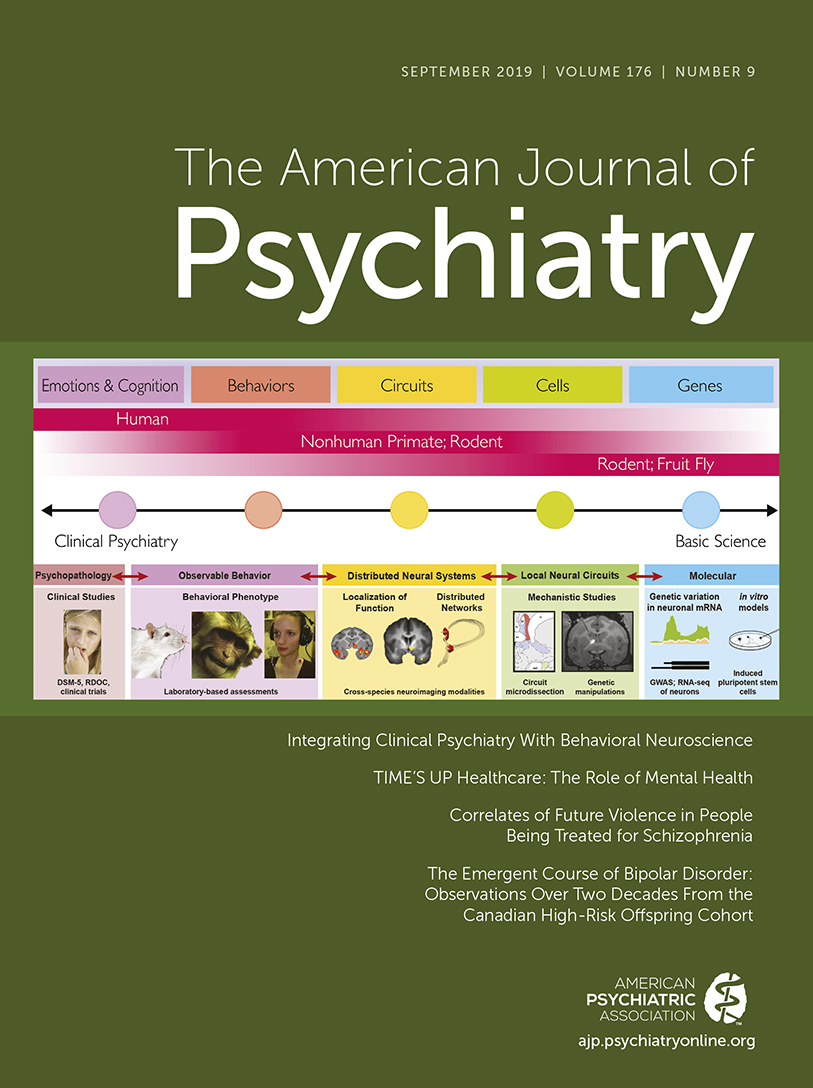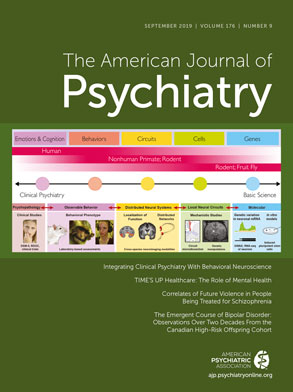What do we know about the relationship between violence and schizophrenia? Violence is more common among people with schizophrenia than among people without mental disorders, roughly twice as frequent when controlling for the substantial effects of comorbid substance abuse (
1). A large number of variables have been associated with this increased risk of violence, with the more robust including younger age, previous violence, antisocial traits, and medication nonadherence (
2). Although risk prediction models appear to be able to identify subgroups of people with mental disorders who are at higher risk for violence, there is little evidence with regard to the accuracy of predictions for people with schizophrenia per se (
3) and reasons to believe that there may be inherent limits on the precision of individual predictions (
4).
Hence, notwithstanding the hundreds of studies of violence in schizophrenia and other psychoses over the past half century, psychiatrists faced with clinical, legal, and societal pressures to identify patients who are likely to engage in violent behavior remain in need of additional assistance to accomplish this task. It is precisely this need that motivates studies like the one by Buchanan et al. (
5) in this issue of the
Journal. Although the findings of this study contribute additional pieces to the puzzle of identifying patients at heightened risk for violence, the study also clearly illustrates many of the limitations of current research strategies.
Capitalizing on data from the multisite Clinical Antipsychotic Trials of Intervention Effectiveness (CATIE) study on the comparative effectiveness of antipsychotic medications (
6), the authors identified a small number of variables associated with an increased risk of violence that resulted in injury to another person. Baseline injurious violence, recent violent victimization, severity of drug use, baseline noninjurious violence, childhood sexual abuse, and medication nonadherence all heightened violence risk, although in the case of the last two variables, the increase was quite limited. Taken individually, there are no surprises here, since all of these have been found to be risk factors for future violence in previous studies. The authors suggest that the simultaneous large effect of having previously perpetrated and experienced violence represents a new contribution, but if so, it is surely a modest step forward.
However, the ways in which the Buchanan et al. study is typical of the literature on violence and mental illness exemplify many of the problems with current approaches. Conducting a secondary data analysis from a study not primarily designed to identify risk factors for violence, the authors were able only to assess those variables that were for other reasons included in the CATIE study. Thus, such presumptively relevant variables as lifetime arrest record and antisocial personality diagnosis appear not to have been available for this analysis. (Previous analyses from this data set showed that youthful antisocial behavior was a significant predictor of violence and comprised a subgroup with different antecedents of violence and responses to treatment [
7,
8].) Moreover, the sample was arguably atypical of people with schizophrenia, consisting of patients who were not doing well on their medication at the time of enrollment, were willing to enter a longitudinal clinical trial, were switched to at least one new medication during the study period, and then were followed intensively by a research team over 18 months (
9). The extent to which a sample such as this is useful in understanding violence among stable, community-dwelling patients with schizophrenia or persons newly discharged from an inpatient hospitalization is unclear.
Indeed, the opportunistic nature of most research on violence and schizophrenia (and other mental disorders) has inhibited progress in identifying the roots of violent behavior and potential preventive measures. Because they are typically reliant on data collected for other purposes, existing studies differ in sampling strategies (e.g., persons hospitalized for schizophrenia versus anyone with a schizophrenia diagnosis), diagnostic inclusion criteria (schizophrenia versus all psychoses), retrospective versus prospective design, independent variables, ascertainment of violence (arrest records versus self-report), and outcome measures (all interpersonal violence versus only injurious violence), among other methodological elements. Thus, systematic reviews and meta-analyses are handicapped by needing to combine data with very different characteristics in an effort to reach generalizable conclusions. Under these circumstances, it can hardly be surprising that—with the exception of variables of large effect such as previous violent history—studies routinely identify different predictors of violence, typically with small effects on overall risk.
Compounding this problem is the multifactorial nature of violence itself, with presumably causal factors, most with relatively small contributions to overall risk, having been identified at the individual, interpersonal, community, and societal levels (
10). Individual-level factors include both demographic and biological variables, with violent behavior demonstrating moderate heritability (
11). Violence differs in its goals (instrumental versus impulsive violence), its relationships between perpetrators and victims (intimate versus stranger violence), its nature (physical versus sexual violence), and its relationship to underlying mental disorders, if any. Indeed, even when perpetrated by people with serious mental disorders, only a small proportion of violence appears to be linked directly to symptoms of the disorders themselves (
12). There is no inherent reason why the causal factors behind gang violence should be the same as those that precipitate assaults on an intimate partner, or why violence committed during a robbery should share predictors with an apparently unprovoked attack on a roommate, even when all are committed by a person with schizophrenia. By studying violent behavior as though it reflects a single phenomenon—with the Buchanan et al. study again being typical of the literature in this regard—research on violence and schizophrenia has been handicapped in identifying causal pathways.
How then can we move research on violence in schizophrenia forward? Without negating the contributions of the many researchers whose work has gotten us to where we are today, I would suggest that more secondary analyses of data collected for other purposes are unlikely to make substantial contributions to our understanding of violence by people with schizophrenia, the predictive accuracy of our models, or the development of preventive interventions. What is needed are prospective studies with violence as the primary outcome, sufficiently well powered to allow the identification and integration into multivariate models of the many variables that are likely to make some, usually modest, contribution to violence risk. Independent variables should be selected on the basis of their previous association with violence or strong theoretical reasons to believe that such an association can be demonstrated. Participants must be chosen with an eye to being able to generalize the results either to all people with schizophrenia or, likely more productively, to discrete subgroups that may be at increased violence risk, such as patients with first-episode psychosis (
13). Outcome measures should be robust, preferably based on more than one method of ascertainment. Perhaps most useful of all would be the development of consensus methods for research on violence in schizophrenia and other mental disorders. Common sampling strategies, definitions of independent variables, and outcome measures would allow data to be aggregated across studies to increase the validity of systematic reviews and meta-analyses.
Notwithstanding that the importance of many of these approaches has been recognized for several decades (
14), they continue to be honored largely in the breach by most research on violence and mental illness. However, another area of schizophrenia research demonstrates the value of pooling data in large consortia with agreement on analytic strategies. Research on the genetics of schizophrenia was stymied by many of the same problems affecting violence research, including a focus on a small number of predictive variables (“candidate genes”) that failed to replicate across studies (
15). However, substantial advances have been made by an international consortium of researchers, the Psychiatric Genomics Consortium, that has pooled data from many different samples and used a technique, genome-wide association studies, that allows a vast number of genetic variants to be taken into account simultaneously (
16). Although analogies across fields of research are always imperfect, the consortium approach is very much worth considering here.
As I have suggested elsewhere, however, there are likely to be irreducible limits to the ability to predict violence in schizophrenia or any other mental disorder due to “the unknowable contingencies of life. Will a person’s spouse leave or will the person lose his job or his home? As a consequence, will the person return to drinking, stop taking medication, or reconnect with friends who have continued to engage in criminal behaviors?”
(17, p. 819). Thus, whatever the degree of violence risk a person is thought to present, particularly in the absence of demonstrated strategies for reducing that risk (
18), the tasks of clinical care should focus on providing the best available evidence-based treatment and necessary psychosocial support.

